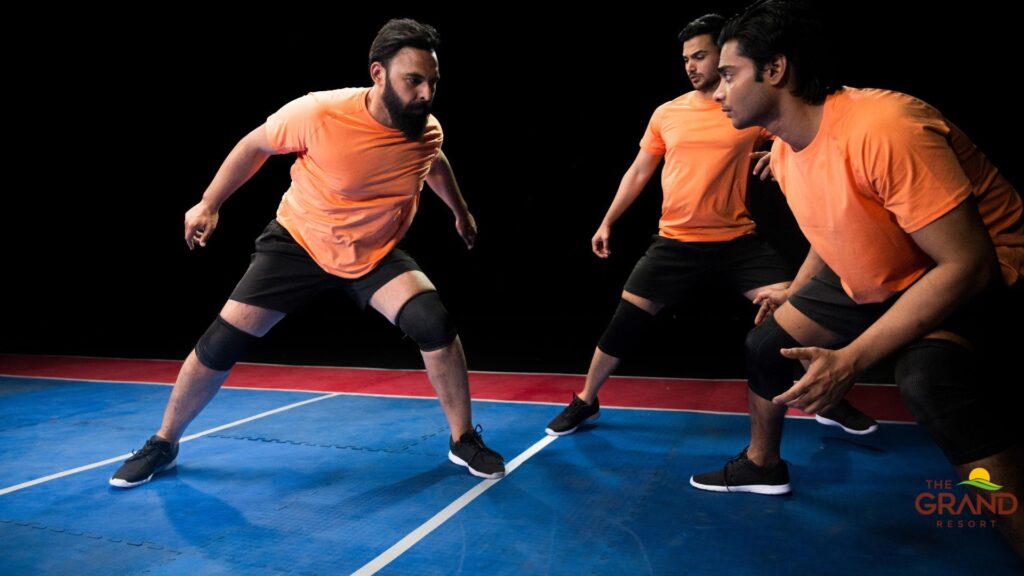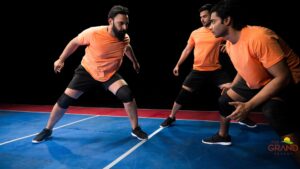Kabaddi. The name itself evokes images of breathless chants, lightning-fast raids, and powerful tackles. More than just a sport, Kabaddi is a pulsating piece of India’s soul, a 4,000-year-old tradition that has journeyed from village maidans to the global spotlight. It’s a story of resilience, transformation, and the enduring spirit of an indigenous game that refused to be forgotten.
The Ancient Roots of the Raid Kabaddi in India
Kabaddi’s origins are whispered to lie deep within India’s ancient past, potentially dating back over four millennia. While hard proof is elusive, the game resonates powerfully within epics like the Mahabharata. The tale of Abhimanyu penetrating the seven-layered Chakravyuha formation mirrors the core Kabaddi dynamic: a lone raider against seven defenders. Some legends even suggest the game honours Abhimanyu’s bravery , while others link it to Arjuna’s stealth tactics or even Lord Krishna and Gautama Buddha playing a similar game.
Though India is widely seen as its birthplace, alternative theories point to ancient Tamil Nadu (Sadugudu or Chedugudu) or even Sistan, Iran. Regardless of the exact spot, its initial purpose seems clear: honing vital combat and survival skills like self-defense, agility, breath control, and strategic thinking.
From Folk Game to Formal Sport: Styles and Rules Emerge
Before standardization, Kabaddi thrived under various regional names: Hu-Tu-Tu in the west , Hadudu or Kit-Kit in the east , and Chedugudu in the south. Despite variations, the core raiding concept held firm. Three distinct styles gained prominence:
- Sanjeevani: The foundation of modern Kabaddi. Features player revival (‘one out, one in’) , a 40-minute duration , seven players per side , and bonus points for an ‘All Out’.
- Gaminee: Players stay out until the entire team is out. No time limit; played until a set score is reached. Also features seven players.
- Amar: Similar time limit to Sanjeevani , but ‘out’ players remain on court, earning the opposition points. Popular in Punjab and Haryana.
Another key variation is Circle Style Kabaddi, played on a circular pitch. The eventual ‘National Style’ synthesized elements, primarily from Sanjeevani, paving the way for national and international play.
Building a National Identity: Formalization and Growth
The early 20th century marked Kabaddi’s shift towards a formal sport, with Maharashtra leading the charge. The first rules were drafted in the 1920s and applied in a 1923 All India Tournament in Baroda.
International exposure came via a demonstration at the 1936 Berlin Olympics , followed by inclusion in the 1938 Indian Olympic Games in Calcutta.
The formation of the All India Kabaddi Federation (AIKF/KFI) in 1950 and later the Amateur Kabaddi Federation of India (AKFI) in 1972/73 was pivotal. These bodies standardized rules, organized national championships (first men’s nationals in 1952/1955, women’s in 1955) , and introduced junior competitions.
Integrating Kabaddi into university (1961) and school (1962) sports programs further embedded it into the national athletic structure. By the late 20th century, Kabaddi was a recognized national sport, even becoming the official state sport in regions like Tamil Nadu, Punjab, and Maharashtra.
India on the World Stage: An Era of Dominance
India championed Kabaddi internationally, starting with demonstrations at the 1951 and 1982 Asian Games in New Delhi. Its inclusion in the South Asian Federation (SAF) Games from 1984 was a key step.
The breakthrough came in 1990 when Kabaddi became a medal sport at the Beijing Asian Games. This kicked off an era of incredible Indian dominance:
- Asian Games (Men): 7 consecutive golds (1990-2014). After a bronze in 2018 , India reclaimed gold in 2022 (held 2023).
- Asian Games (Women): Gold in 2010 and 2014. Silver in 2018 , followed by gold again in 2022 (held 2023).
- Kabaddi World Cup (Standard Style – IKF): India won all three men’s editions (2004, 2007, 2016) and the inaugural women’s edition (2012) , defeating Iran each time.
- Kabaddi World Cup (Circle Style): India won 6 of 7 men’s titles between 2010-2016.
The 2018 Asian Games results, however, signaled the rise of competitors like Iran and South Korea.
Table: India’s Performance in Asian Games Kabaddi (Men)
| Year | Host | India’s Rank | Medal |
|---|---|---|---|
| 1990 | Beijing | 1st | Gold |
| 1994 | Hiroshima | 1st | Gold |
| 1998 | Bangkok | 1st | Gold |
| 2002 | Busan | 1st | Gold |
| 2006 | Doha | 1st | Gold |
| 2010 | Guangzhou | 1st | Gold |
| 2014 | Incheon | 1st | Gold |
| 2018 | Jakarta-Palembang | 3rd | Bronze |
| 2022 | Hangzhou | 1st | Gold |
Table: India’s Performance in Asian Games Kabaddi (Women)
| Year | Host | India’s Rank | Medal |
|---|---|---|---|
| 2010 | Guangzhou | 1st | Gold |
| 2014 | Incheon | 1st | Gold |
| 2018 | Jakarta-Palembang | 2nd | Silver |
| 2022 | Hangzhou | 1st | Gold |
Table: India’s Performance in Kabaddi World Cup (Standard Style – IKF)
| Year | Host | Gender | India’s Rank | Medal | Runner-up |
|---|---|---|---|---|---|
| 2004 | Mumbai | Men | 1st | Gold | Iran |
| 2007 | Panvel | Men | 1st | Gold | Iran |
| 2012 | Patna | Women | 1st | Gold | Iran |
| 2016 | Ahmedabad | Men | 1st | Gold | Iran |
The Game Changer: How the Pro Kabaddi League Rewrote the Rules
Despite its international success, Kabaddi remained largely perceived as a rural sport. The launch of the Pro Kabaddi League (PKL) in 2014 changed everything. Inspired by the IPL’s success , PKL aimed to repackage Kabaddi for a modern audience.
It worked spectacularly. Using a franchise model, player auctions, celebrity owners , and slick production , PKL transformed the viewing experience. Moving indoors onto mats and introducing rules like the 30-second raid , ‘Do-or-Die’ raids , and ‘Super Tackles’ injected pace and drama.
PKL quickly became India’s second most-watched league after the IPL. Season 1 saw 435 million viewers , and recent seasons continue to draw massive audiences (Season 10 reached 351 million viewers ).
Table: Pro Kabaddi League (PKL) Viewership Growth (Select Seasons)
| Season | Year | Reported Viewership (Millions) | Source(s) | Notes |
|---|---|---|---|---|
| Season 1 | 2014 | 435 | Inaugural season total viewership | |
| Season 10 | 2024 | 226 | First 90 matches | |
| Season 10 | 2024 | 351 | Total viewership (highest in 4 years) | |
| Projected | 2024 | ~400 | Expected reach for Season 11 |
(Note: Viewership figures can vary based on reporting methodology and timeframe)
This surge reshaped Kabaddi’s image from “rustic” to modern and glamorous , attracting urban viewers, youth, and women. Commercial success followed, with significant sponsorships and media rights deals (Star India’s 2021-25 deal valued at over ₹180 crore/year ).
Most importantly, PKL revolutionized player livelihoods. Auction prices skyrocketed, with players like Pawan Sehrawat fetching over ₹2.6 crore , turning Kabaddi into a viable professional career and creating national stars.
However, PKL still trails the IPL significantly in overall commercial value.
Table: Comparison of PKL vs IPL (Approximate Commercial Metrics)
| Metric | Pro Kabaddi League (PKL) | Indian Premier League (IPL) | Source(s) |
|---|---|---|---|
| Annual Ad Revenue | ~₹350 Crore | ~₹10,000 Crore | |
| Average Team Value | ~₹200 Crore | ~₹10,000 Crore | |
| Media Rights (Annual) | ~₹180 Crore (2021-25) | ~₹9,678 Crore (2023-27) | |
| Viewership Reach (Est.) | ~200-400 Million | ~600 Million |
(Note: Figures are approximate and based on various reports; methodologies may differ)
Kabaddi Now: Thriving League, Future Challenges
Ten seasons in, PKL remains a strong force, boasting high viewership and growing commercial interest. However, maintaining fan engagement during the long off-season and ensuring a robust talent pipeline are key challenges. Grassroots programs like ‘Future Kabaddi Heroes’ (FKH) , franchise academies , and government initiatives like Khelo India are crucial for nurturing talent and bridging the gap between traditional and professional Kabaddi. While participation has increased , ensuring inclusivity across regions and genders remains important.
Beyond the Mat: Kabaddi’s Enduring Cultural Heartbeat
Kabaddi’s significance runs deeper than sport; it’s woven into India’s cultural identity, especially in rural areas. For centuries, it’s been part of village life, festivals like Vaisakhi and Lohri , and social gatherings. Its accessibility (no equipment needed) made it ubiquitous.
The game embodies values like strength, courage, teamwork, and resilience. The raider vs. defense dynamic reflects societal themes – individual bravery versus collective effort. It teaches life lessons about focus, strategy, and endurance.
This cultural depth is mirrored in popular culture. Films like Vennila Kabaddi Kuzhu , Panga , Ghilli , and Okkadu use Kabaddi not just as a backdrop but as a powerful metaphor to explore themes of rural life, social issues, empowerment, and aspiration. PKL amplified this, making players aspirational figures.
The Enduring Raid Continues
Kabaddi’s journey is a testament to an ancient sport’s ability to adapt, professionalize, and capture the modern imagination while staying true to its roots. From mythological echoes and diverse folk styles to national formalization and stunning international dominance, its evolution has been remarkable. The Pro Kabaddi League era catapulted it into the mainstream, creating stars, attracting massive audiences, and changing perceptions forever.
Today, as India’s second most popular sport, Kabaddi navigates the space between tradition and commercialization, facing challenges but brimming with potential. It remains more than a game – a vibrant symbol of Indian strength, community, resilience, and enduring cultural identity, continuing its raid into the future.












